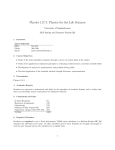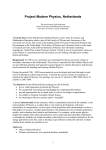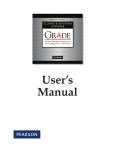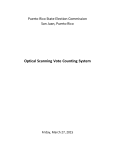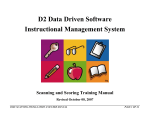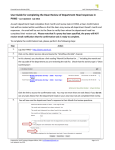Download 2003 Intersession Course Outline
Transcript
6 May 08 1 is2008_course_outline.doc PHYSICS 111.6 – SPRING AND SUMMER SESSION - TERM 1 - 2008 http://www.busybwebdesign.com/phys111/ No. ____ INSTRUCTOR: Brian Zulkoskey, Rm. 115 Physics, ph. 966-6439, [email protected] PREREQUISITES: Physics 30 and Mathematics B30 and C30 OBJECTIVES: - Study of the basic principles of physics and their applications to technology and various scientific fields; - Development of analytical and mathematical skills; - Practical application of the scientific method through laboratory experimentation. ACADEMIC HONESTY (see http://www.usask.ca/honesty/): Students are expected to understand and abide by the principles of academic honesty and to realise that there are potentially serious consequences for dishonest behaviour. LECTURES: TUTORIAL: LABORATORY: 8:30 a.m. – 10:45 a.m. 11:00 a.m. – 12:00 p.m. 1:30 p.m. – 4:30 p.m. Rm. 107 Physics Rm. 107 Physics See Lab Schedule REQUIRED TEXTBOOKS: 1. “Physics”, by Cutnell & Johnson (Seventh edition, Wiley). $114.95 2. “A Laboratory Manual for Physics 111.6” (revised 2006). $7.85 3. “Physics 111.6 Laboratory Worksheets” (revised 2006). $3.75 INTERNET ACCESS: Submission of assignments will be handled exclusively through the Physics 111 website (URL at top of page). The website will also be used throughout the course for the posting of announcements, assignment questions and solutions, test solutions, assignment and test marks, and review material. Students can access the website either through their University account or through another provider. REQUIRED CALCULATOR: Students are required to use a Hewlett-Packard HP 30S or Texas Instruments TI-30X-series calculator for all Physics 111 exams. No other calculator may be used. Students are strongly encouraged to read the user manual and use the calculator on a regular basis. SUPPLEMENTARY MATERIALS: 1. “Student Study Guide” for Physics, 7th ed., by Cutnell & Johnson. $49.95 2. “Student Solutions Manual” for Physics, 7th ed., by Cutnell & Johnson. $47.95 3. “Multiple Choice Questions for Physics 111.6” (February 1997). $9.40 SUPPLIES: - Duo-tang folder and 3-hole-punched sheets of ¼" graph paper (for laboratory) - Geometry Set (compass, ruler, protractor, right triangles) COMPOSITION OF FINAL GRADE: Assignments.................................……............................. 7% Laboratory Work.........................…….............................. 20% TEST 1 Tuesday, May 27, 1:30 p.m.…….......……........ 11% TEST 2 Tuesday, June 10, 1:30 p.m.…........…............... 11% TEST 3 Tuesday, June 17, 1:30 p.m..……...................... 11% Final Exam Wednesday, June 25, 9:00 a.m.……............ 40% 6 May 08 2 is2008_course_outline.doc CLASS ORGANIZATION: Lectures: • You may find that the format of the lecture portion of this class is somewhat different from what you have encountered in previous science classes. Rather than my regurgitating the textbook material in the lectures, I expect you, the students, to take an active part in the class. You will be expected to have read the appropriate sections of the textbook prior to each lecture. • The lecture period will be broken into two segments: 8:30 to 9:30 a.m. and 9:40 to 10:45 a.m. • You are expected to inform me of any difficulties and of your views on the way the course is going. Every week you will be asked to hand in a statement about any difficulties you are encountering in the course and suggestions for improving the course, plus any other comments that you feel are relevant. Place the number on the top of the front page of this package – BUT NOT YOUR NAME – on your comments. (Nobody knows which number you have been assigned.) This ensures that your comments are anonymous (and thus, hopefully, honest and frank) while allowing me a channel to reply to your comments on an individual basis. These comment sheets are due May 16, 23, 30, and June 6, 13, and 20 (Fridays). • You will also be asked to submit an anonymous class evaluation just before the end of the session. Problem Assignments: • There will be weekly homework assignments consisting of multiple choice problems. • You should keep a separate notebook for your homework. Solve each problem with a complete written solution, following the methods outlined in the lectures. • Compare your answer with the choices given in the question. If there is a match, then indicate your selection on the Assignment Submission form on the Physics 111 IS 2008 Website (http://www.busybwebdesign.com/phys111/). If you do not get a match, you have made a mistake in your solution; you should go back and check your work. • The assignments are due on Fridays (or Mondays for some assignments) by 12:00 p.m. (noon). Late assignments will not be accepted. Assignments not submitted will receive a mark of zero. • The solutions will be posted to the Physics 111 Website and will remain posted for the duration of the course. • The marks for each assignment will be posted on the website early in the following week. Additional Resources: • Previously-used midterms and final exams are available on the website. Examinations: • A formulae sheet will be provided for use during the examinations (including the final). A copy of this sheet is attached to this package. The examinations (midterms and final) will consist of multiple choice qualitative questions comprising about 1/3 of the marks, one- or two-step problems comprising about 1/3 of the marks, and hand-marked problems comprising about 1/3 of the marks. 6 May 08 3 is2008_course_outline.doc Final Examination Students who obtain an average mark of less than 30% on the three tests will be excluded from the final examination. The instructor will submit a computed grade for the course which factors in the final examination as a zero. If a student misses one or more tests with permission of the instructor, then the same rule shall apply but the average shall be determined from the tests that were written. A mark of 0 is assigned to a test that is missed without permission. Etiquette Email Etiquette: • All emails to Professors, lab instructors, department administrators, etc. are official communication with the University. • Good rules to follow: • Course name in subject header, e.g., “PHYS 111 - Test 2 Question” • Always address recipient courteously, e.g., “Dear Prof. Smith,” • Always include your name, student number, and course name & section in your email. • Use full sentences and describe your question or situation completely and clearly. Be concise. • Re-read your complete message before sending. Exam Etiquette/Rules: • Turn off cell phones before entering the examination room. • Only Hewlett-Packard HP-30S or Texas Instruments TI-30X-series calculators may be used. No other electronic device is allowed at your desk (e.g. cell phone, pager, PDA, iPod, MP3 player, electronic dictionary…) • No written material is allowed at your desk other than the test paper, formulae sheet and OpScan sheet. • Bring your student card, a pen, two soft-lead (HB) pencils, eraser, and straightedge. Physics 111 Laboratory Policy 1. Laboratory work is an integral part of the course. A student will not receive a passing grade for the course unless all of the experiments have been completed. Failure to complete the laboratory work will result in failure in the course. 2. Withdrawing from Physics 111 implies withdrawing from the laboratory work in the course as well. You may not continue laboratory work after withdrawing from the course, even if you decide to continue to attend the lectures. 3. If you withdraw from Physics 111 after completing at least the first term with an average laboratory mark of at least 70%, and you then repeat the course in a later session but within three years, you may request exemption from the first term labs. Your first term laboratory mark will be the average mark you received for the experiments already performed. You must then perform the remaining experiments in second term. 4 is2008_course_outline.doc 4. If you complete Physics 111 with a final grade of 40% or higher and complete the laboratory work with an average laboratory mark of at least 70%, and you then repeat the course in a later session but within three years, you may request exemption from all of the labs. Your laboratory mark for the year will be the average mark you received for the experiments already performed. 6 May 08 5. If you complete Physics 111 with a final grade of less than 40%, or if you are excluded from the final examination, or if you withdraw after the WF deadline, no laboratory exemption will be granted (neither partial nor full). 6. Laboratory exemptions are not automatic. To request an exemption from laboratory work, you must contact Laverne Sander ([email protected]) or Brian Zulkoskey. B. Zulkoskey 6 May 2008 HINTS ON LECTURE PREPARATION, NOTE-TAKING, AND THE USE OF THOSE NOTES: • • • • • • • • • Prior to each lecture, check the lecture schedule to see which sections of the text will be covered. Read the appropriate sections of the text, including the worked examples. You may wish to make brief study notes summarizing the key concepts of each section. Be prepared to answer questions in class on the appropriate material. Note any sections of the text or parts of the examples that you have difficulty understanding. It is generally not necessary to make copious notes of what is presented on the blackboard. While it is important to make notes of the key concepts covered in class, try to spend more time LISTENING than copying without thought. Derivations done in class are to show where the various equations originate, but you will not be asked to reproduce the details of these derivations. Read through your notes as soon as possible after the lecture. You might find it worthwhile setting aside a definite period of time each lecture day for this purpose. Correct any errors you find and fill in any missing parts. NOTE: Problems arise when you learn incorrect material or you misunderstand material or you do a problem with errors. Your mind retains the incorrect material, even if you are corrected by an instructor or by receiving a poor mark. To overcome this, you must spend more time on correcting your ideas (to swamp the errors) than you did on the original incorrect learning. Going through your notes shortly after a lecture is valuable. It will help you to retain the material in your mind and thus benefit you greatly when exam time comes. Also, this procedure, plus some study, should keep you up to date. That in turn will help you get more out of the next lecture, thereby accelerating your intake and retention of the course material. Try to answer any questions that arise in your mind from your reading of your notes. If you cannot answer all questions before the next lecture then ask for the missing answers at the beginning of the next lecture. Spend a few minutes outlining in your mind where the current lecture material is leading. Instructors do point out the relevance of the material they cover, and they do indicate where the material leads and why. However, in general, students do not pay much attention to these aids, perhaps because they won't appear on an exam and perhaps because hard thinking is required to make use of these aids. This hard thinking is worthwhile – organized material is easier to retain than isolated facts. Many competent students fail in University not because of a choice, a single decision, but rather because of day-by-day putting-off of work or day-by-day choices of what to do with the next few 5 is2008_course_outline.doc hours. Do not let day-by-day or hour-by-hour casual choices determine the outcome of your university career. 6 May 08 PROBLEM SOLVING: To do well in physics you must understand the material and not simply memorize equations. This understanding can be gained by following through the examples discussed in class and in the textbook, but most importantly, by doing some of the problems at the end of each chapter and (of course) the problem assignments. PROPOSED LECTURE SCHEDULE - PHYSICS 111.6 SPRING & SUMMER SESSION – TERM 1 – 2008 Text: Physics, Cutnell & Johnson (7th Edition) Lecture Number 1 2 3 4 5 6 7 8 9 10 11 12 13 14 15 16 Date Sections to be Covered May 12 Mon May 13 Tue May 14 Wed May 15 Thu May 16 Fri May 20 Tue May 21 Wed May 22 Thu Introduction (1.1), Units (1.2, 1.3), Math Review (algebra), discussion of Scientific Method Displacement, Speed, Velocity, Acceleration (2.1 to 2.3), Constant acceleration motion in one dimension (2.4 to 2.5) 1-d motion cont. (2.6, 2.7), Trigonometry (1.4), Vectors (1.5 to 1.8), Kinematics in two dimensions (3.1) Kinematics in 2-d cont. (3.2), Projectile Motion (3.3), Force and 3.4 Mass (4.1), Newton's 1st and 2nd Laws of Motion (4.2 to 4.4) Newton’s 3rd Law (4.5), The gravitational force and weight (4.6, 4.7), The normal force (4.8), Friction (4.9) Tension (4.10), Applications of Newton’s Laws of Motion (4.11, 4.12), Uniform Circular Motion (5.1, 5.2) Uniform Circular Motion (5.3 to 5.7) May 23 Fri May 26 Mon May 27 Tue May 28 Wed May 29 Thu May 30 Fri Jun 2 Mon Jun 3 Tue 6.9 Work (6.1), Kinetic Energy (6.2), Gravitational Potential Energy (6.3), Conservative and Non-conservative Forces (6.4), Conservation of Energy (6.5, 6.6, 6.8) Power (6.7), The impulse-momentum theorem (7.1), Conservation of Linear Momentum (7.2) Collisions in One and Two Dimensions (7.3, 7.4), Rotational Kinematics (8.1 to 8.5) Rotational Kinematics (8.6), Torque (9.1), Rigid objects in equilibrium (9.2) Rotational Dynamics (9.2, 9.4 to 9.6) Omit 7.5 8.7 9.3 Simple Harmonic Motion (10.1 to 10.2) Simple Harmonic Motion (10.3), Fluid Statics (11.1 to 11.4) 10.4 to 10.8 Fluid Statics and Dynamics (11.5 to 11.10) 11.11 Waves (16.1 to 16.4), Sound (16.5), Sound Intensity (16.7) 16.6, 16.10, 16.11 6 6 May 08 Lecture Number 17 18 19 20 21 22 23 24 25 26 27 28 29 30 31 is2008_course_outline.doc Date Sections to be Covered Omit Jun 4 Wed Jun 5 Thu Decibels (16.8), Doppler Effect (16.9), Linear Superposition (17.1), Interference of Sound Waves (17.2), Beats (17.4) Transverse Standing Waves (17.5), Longitudinal Standing Waves (17.6), The Origin of Electricity (18.1), Charged Objects (18.2), Conductors and Insulators (18.3), Charging (18.4), Coulomb’s Law (18.5) Coulomb’s Law cont. (18.5), The Electric Field (18.6), Electric Field Lines (18.7), Potential Energy (19.1) Electric Potential Difference (19.2, 19.3), Equipotential Surfaces (19.4), Electromotive Force and Current (20.1) Ohm’s Law (20.2), Resistance and Resistivity (20.3), Electric Circuit Relations (20.4, 20.6, 20.7) Safety and the Physiological Effects of Current (20.14), Magnetism (21.1, 21.2) Magnetism (21.3, 21.4), Electromagnetic Waves (24.1 to 24.3), The Reflection of Light (25.1 to 25.2), The Refraction of Light (26.1 to 26.3) The Refraction of Light (26.5 to 26.9) 17.3 Jun 6 Fri Jun 9 Mon Jun 10 Tue Jun 11 Wed Jun 12 Thu Jun 13 Fri Jun 16 Mon Jun 17 Tue Jun 18 Wed Jun 19 Thu Jun 20 Fri Jun 23 Mon Jun 24 Tue 17.7 18.8 to 18.10 19.5, 19.6 20.5, 20.8 to 20.13 21.5 to 21.9 24.4 to 24.6, 25.3 to 25.6, 26.4 The Refraction of Light (26.10 to 26.14) Physical Optics (The Wave Nature of Light) (27.1, 27.2, 27.7), Particles and Waves (29.1, 29.2) Particles and Waves (29.3, 29.4), Atomic Physics (30.1) 27.3 to 27.6, 27.8, 27.9 29.5, 29.6 Atomic Physics (30.2, 30.3, 30.7, 30.8) 30.4 to 30.6 Atomic Physics cont. (30.8), Structure of the Nucleus (31.1, 31.2), Binding Energy (31.3), Radioactivity (31.4) Radioactivity cont. (31.4), The Neutrino (31.5), Radioactive Decay (31.6), Radioactive Dating (31.7) Radioactive Decay Series (31.8), Detectors of Radiation (31.9), Biological Effects of Ionizing Radiation (32.1), Induced Nuclear Reactions (32.2), Nuclear Fission (32.3), Nuclear Reactors (32.4), Nuclear Fusion (32.5) 30.9, 30.10 32.6, 32.7 7 6 May 08 is2008_course_outline.doc NAME: __________________________ EDUCATION BACKGROUND: (Other university-level courses taken in the past) ___________________________________________________________________________ ___________________________________________________________________________ University Program in which you are, or wish to be, enrolled: Optometry Medicine Dentistry Vet Med Physical Therapy Chiropractic Other: _____________ Agriculture Biochemistry Microbiology Education Engineering Geology Unclassified Please write a short note explaining why you are taking university classes and, in particular, your reasons for registering in Physics 111.6.








